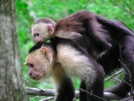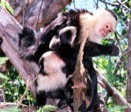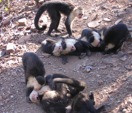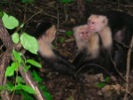








Ethogram - Behavioral Videos
These are video clips of behaviors that are part of the repertoire of the monkeys at Lomas Barbudal. The codes are the behavioral codes researchers use to record these behaviors during data collection. Click the link to see the videos and descriptions of the behaviors.
Tail Branch Drag
Behavior: Tail branch drag
Description: A monkey grasps a branch in his prehensile tail and drags it along the ground. In this clip it is a small branch, dragged relatively noiselessly, but often it is a larger branch, dragged through leaf litter so that it makes a lot of noise.
Context: Used as part of an aggressive display to group members, other groups, or other species.
Piloerect
Behavior: Piloerection
Description: The hair stands on end. This is hard to see in the absence of direct comparison with the same individual when NOT piloerect. The shoulders are the body part where piloerection is most obvious.
Context: Alpha males are piloerect almost all of the time. Other group members become piloerect only when experiencing high levels of social arousal, e.g. in intergroup encounters.
Knead Tail
Behavior: Knead tail
Description: The monkey scratches and/or kneads the prehensile part of the tail.
Context: This is typically performed during stressful moments when being threatened by other group members.
Urine Rub
Behavior: Urine rub/wash
Description: The monkey uses one hand to splash urine on to other parts of the body (particularly those parts used to grip surfaces - e.g. hands, feet, tail tip).
Context: Can be performed any age sex at any time, but is most commonly performed by alpha males.
Yawn
Behavior: Yawn
Description: Identical to human yawn. Relative to a fear grin or open-mouth threat, the mouth is open wider and less is seen of the incisors.
Bipedal Scan
Behavior: Bipedal scan
Description: Standing on hindquarters without touching other surfaces with the hands.
Context: Most often seen during social vigilance, during predator encounters, or while hunting insects.
Attempted Food Theft
Behavior: Attempted food theft
Description: A begging monkey makes physical contact with a food item and pulls on it, but is rebuffed by the food owner (by pushing, threatening or pulling away the item) so that the food remains with the original owner.
Food Handle
Behavior: Food handle
Description: The begging monkey touches the food that is in the possession of the other monkey, but does not eat this food or take it away from the other monkey.
Food Interest
Behavior: Food interest
Description: A monkey peers at the foraging activities of another monkey at fairly close range (i.e. within less than 1 body length away, and usually no more than a few centimeters away), without touching the food, though the observing monkey is often touching the foraging monkey.
Fear Grin
Behavior: Fear grin
Description: The monkey opens its lips very slightly, barely showing the teeth, and pulls the corners of the lips back towards the cheeks. The mouth is not open as widely as in a threat face and the jaw may actually be closed.
Context: This behavior is performed when the monkey is nervous. In the attached clip (which is a bit more subtle than most fear grins), the monkey seems worried about the approach of a dominant animal.
Staccato Scream
Behavior: Staccato scream (machine gun scream)
Description: This is a rapid sequence of high frequency, loud, atonal, pulsed sounds.
Context: During fights that are not of extremely high intensity.
Undulating Scream
Behavior: Undulating scream
Description: This scream is loud, high pitched, and frequency-modulated.
Context: This scream is produced during fights characterized by more severe aggressive intensity and/or greater emotional arousal than in fights that include staccato screams only.
Friendly Climb
Behavior: Friendly Climb
Description: A monkey climbs on another's back, not simply as a way of passing over it in transit because the monkey is in its way, or to assume a sexual mount or "infant mount", but as a social activity. It looks as if one individual is using the other as a climbing toy.
Context: Usually this is performed by infants to mothers or alloparents who are resting.
Social Fur Rubbing
Behavior: social fur-rubbing
Description: Two monkeys who are in physical contact rub a substance into their fur. The substance can be a fruit, insect, leaf or sap. They may rub it into their own fur or the fur of the companion, and accompanying behaviors often include drooling, eyes or nose running, and squinting.
Sucking On Body Parts
Behavior: Sucking on body parts
Description: A monkey takes the body part of another monkey (usually fingers, toes, ears or tail) and inserts it in his mouth, sucking on it for several seconds and sometimes more than a minute.
Context: This behavior occurs typically only between monkeys who are close friends, in a relaxed context, e.g. during a grooming or resting period.
Tongue Out
Behavior: Tongue Out
Description: The monkey protrudes its tongue for a few seconds, curling it down towards the chin.
Context: This is most common in infants and juveniles, though adults can do it as well. It is more common in windy conditions and does not seem to be a social behavior.
Nipple Palpate
Behavior: Nipple palpate
Description: One monkey grasps the nipple of the other monkey and squeezes it gently and repeatedly.
Context: This is found in two quite distinct contexts. Infants will palpate one of their mother's nipples while nursing from the other nipple, apparently to stimulate milk flow. The other context is in the aftermath of fights (as in this clip), in which one or both opponents will seize the other's nipples and knead them, apparently as an attempt at reconciliation.
Sniff Scent Of Other Monkey
Behavior: Sniffing monkey scents left behind on a substrate
Description: Monkeys often run over to sniff the scents left behind when others have urinated or rested on a branch or rock. In this clip you see a monkey sniffing the urine deposited by the monkey on the left.
Tooth Grind/Tooth Clack
Behavior: Tooth grind (tooth clack)
Description: A monkey repeatedly and loudly clacks his jaws together, so that the teeth make a loud noise as they contact one another.
Context: This is most often seen by adult males during intergroup encounters, when they are highly aroused and glaring at their enemies.
Aggressive Bounce
Behavior: Aggressive bounce
Description: The monkey leaps up and down in place, while glaring at or threatening an opponent.
Aggressive Nip
Behavior: Aggressive nip
Description: A monkey gives a gentle, restrained bite to another monkey.
Open Mouth Threat
Behavior: Open-mouth threat
Description: The monkey opens its mouth, exposing the teeth, while glaring at the opponent.
Headflag
Behavior: Headflag
Description: A monkey jerks his head back and forth, directing its gaze alternately between the monkey who is target of its aggression and a monkey from whom he is soliciting aid. The gaze remains fixed longer on the target than on the solicitee. In this clip, the juvenile on the left is threatening someone off camera and repeatedly headflagging to the alpha male on the right in order to request aid against the target.
Cheek To Cheek Posture
Behavior: Cheek-to-cheek posture
Description: Two allied monkeys align their bodies side by side in contact, typically with the cheeks touching. Typically they glare or threaten towards a common opponent while doing this.
Overlord Posture
Behavior: Overlord
Description: One monkey gets on top of another monkey, hugging its torso, as they confront a common enemy (with can be a monkey or a non-monkey). The top monkey is positioned further forward than in a sexual mount position. Typically both of the monkeys threaten or glare at a common enemy while in this posture, and often their heads are stacked (though not in this clip).
Infant Wrestle
Behavior: Infant wrestle or infant throw
Description: A monkey struggles to knock or pull an infant off of its back.
Context: This most often happens when an alloparent is carrying an infant that has started to coo and twitter for its mother.
Pound
Behavior: Pound
Description: A monkey takes an object (usually a fruit, like the Luehea fruit in this clip) and beats it against another substrate repeatedly.
Play Bite
Behavior: Play bite
Description: Biting another monkey in a gently, restrained way, in the context of play.
Play Invite
Behavior: Play invite
Description: The mouth is opened with the lips relaxed rather than stretched to expose the teeth. Although the canines may still show in a play invite face, the other teeth do not show as much as in an open-mouth threat face.
Chicken Fight
Behavior: Chicken fight
Description: Two or more monkeys hang by their tails and swat at one another with their hands and feet, sometimes play wrestling and play biting as well.
Context: This is a form of play.
Play Pull
Behavior: Play pull
Description: One monkey grabs an appendage of another monkey and tugs on it, sometimes dragging the monkey away. This is done in the context of play.
Play Pounce
Behavior: Play pounce
Description: One monkey leaps on top of another as a way of initiating or continuing a bout of play wrestling.
Play Wrestle
Behavior: Play wrestling
Description: Two monkeys grapple silently with one another.
Context: Generally accompanied by play bites and perhaps play invite faces.
Self-handsniff
Behavior: Self-handsniff
Description: A monkey cups her hand over her nose and mouth and inhales for several seconds, often over a minute.
Context: This happens during rest and social time, rather than during foraging time.
Duck Face
Behavior: Duck face
Description: The lips are pressed together and protrude.
Context: This occurs in the context of courtship and non-conceptive sex, both as a prelude to sex and during sex. It is often accompanied by sex turns, pacing, sex squeaks, grunts, wheezes, and copulation.
Sex End
Behavior: Sex end
Description: One monkey breaks off a copulatory event with another monkey.
Sex Dance
Description: Two monkeys pace back and forth while fixing their gaze on one another and vocalizing with rhythmic exchanges of some combination of the following calls: grunts, wheezes or squeaks. They often exhibit "duck faces" and "twists/turns" in which they spin part or all of their bodies while making duck faces at the dance partner. These dances frequently lead up to a copulation (conceptive or non-conceptive). Any age-sex combination except for dorsal infants can engage in sex dances.
Sex Pace
Behavior: Sex pace
Description: A monkey walks back and forth while staring at a prospective partner, and often while making a "duck face" and vocalizing (sex grunts, sex squeaks or wheezes).
Sex Grunt
Behavior: Grunt
Description: This is an atonal, noisy sound most often exhibited during sex dances or while making duck faces at another monkey. It is often produced in rhythmic exchanges between two dance partners.
Mobile Mount
Behavior: Mobile mount
Description: One individual mounts another, clutching the bottom individual's legs with his/her feet and the torso with the hands and arms, with genitals in contact. The bottom individual locomotes while the top individual retains this position. In the attached clip, the top individual has not yet become fully mounted with the left foot, but in a typical mobile mount, both feet clutch the others' legs.
Sex Mount
Behavior: Sex mount
Description: One individual gets on top of another in a dorsal-ventral position, grasping the torso of the bottom individual with his/her hands, with genitals touching. The mounter's feet are usually on the ground, but can grasp the legs of the mountee.
Sex Rock
Behavior: Sex rock
Description: A gentle forward-backward rocking motion while two individuals are engaged in a sex mount.
Sex Turn
Behavior: Sex twist (sex turn)
Description: A monkey pivots his/her body and head while staring at its partner in a sex dance. The monkey doing the sex twist also is exhibiting a duck face and has just been pacing, but occasionally a twist can be performed without pacing first.
Sex Thrust
Behavior: Sex thrust (i.e. copulation)
Description: This is the standard mammalian dorsal-ventral copulation, combining a mount and pelvic thrusts with genital contact.
Context: This can occur between any age-sex class combination.
Food Peep
Behavior: Food peep (food associated call, "huh")
Description: Typically a short tonal call with clear harmonics, but a more guttural variety (growly food call) also exists. The non-growly variety is what is heard in this clip, performed by several monkeys foraging in the same tree as the monkey on camera.
Gargle
Behavior: Gargle
Description: This is a guttural, raspy, atonal call.
Context: This call is most often produced by infants to adult males, but is also produced by adult females who are new mothers as they interact with the alpha male. Other behaviors that accompany a gargle typically include head shakes, wrinkly faces, and lip smacks.
Mild Vocal Threat
Behavior: Mild vocal threat ("heh")
Description: A short squeaky vocalization that is often repeated as part of a sequence, during which the mouth is open and the teeth are bared. Sometimes the tongue wiggles during this vocalization. The monkey glares at the target of the aggression while emitting a mild vocal threat.
Intense Gargle
Behavior: Intense gargle
Description: This is a loud, guttural, atonal sound produced in rhythmic sequences.
Context: It is often performed in dances along with wheezes. In the attached clip (in which the monkey on camera is not vocalizing at all), the monkey doing the high-pitched vocalizations is wheezing, while the other off-camera monkey is doing the intense gargles. This vocalization is common in dances after fights.
Wheeze
Behavior: Wheeze
Description: This is a high-pitched, long tonal whistle.
Context: It is often performed in dances along with intense gargles. In the attached clip (in which the monkey on camera is not vocalizing at all), the monkey doing the high-pitched vocalizations is wheezing, while the other off-camera monkey is doing intense gargles.
Snake Alarm
Behavior: Snake alarm
Description: A short, tonal call produced when a monkey sees a dangerous snake.
Sex Squeaks
Behavior: Sex squeak
Description: A series of high pitched warbly vocalizations typically produced during sex or during sex dances. Often the monkey producing sex squeaks or dancing with the sex squeaking monkey will also emit some grunts.

